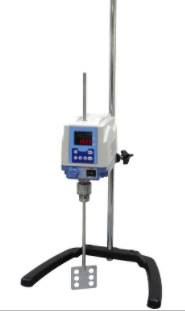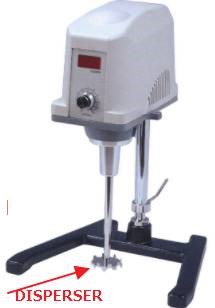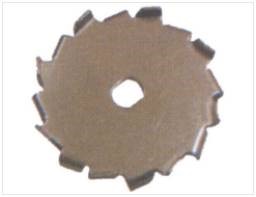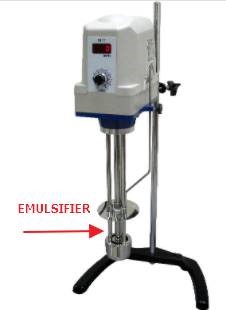MRC range of mechanical and electronic, for stirring tasks in the laboratory and industry.
Mechanical overhead stirrers usually reach speeds of up to 3000 rpm. It comes with an impeller in the shape of a cross or pedals or wings.
When choosing a Over head Stirrers, choose a suitable engine according to the viscosity of the material and the amount of material.For aqueous liquid in small quantities up to 10 liters, a small motor up to 50 watts and a speed of up to 2000 rpm will suffice.For liquid water up to 50 liters, a motor of up to 100 watt and a speed of up to 2000 rpm will suffice.For a viscous material like oil paint up to 5 liters, a 200 watt motor up to 500 rpm is needed.For a volume of 10 liters, a 350 watt motor up to 500 rpm is needed.

High-speed disperser over 3000 rpm with a tooth-shaped impeller, tooth down, tooth up. Intended for mixing powders in liquids mainly in the cosmetics industry.


Emulsifier-similar to a homogenizer but in a different method of pumping two different liquids that want to connect them

What are Overhead Stirrers?
Overhead stirrers are motorized mixing devices designed to agitate liquids or suspensions in containers. Unlike magnetic stirrers, which are limited to small volumes and lower viscosities, overhead stirrers are robust and capable of handling large volumes and thick substances. They are mounted on stands, with a stirring shaft extending into the material to perform mixing.
Key Components of Overhead Stirrers
- Motor Unit:
- Provides the rotational force needed for stirring.
- Can vary in power to suit different viscosities and volumes.
- Control Panel:
- Allows users to adjust speed, torque, and sometimes time.
- Advanced models may include digital displays and programmable settings.
- Stirring Shaft:
- Connects the motor to the mixing element (impeller or blade).
- Made of durable, corrosion-resistant materials like stainless steel.
- Mixing Impeller or Blade:
- Attached to the shaft, this component interacts directly with the substance being mixed.
- Different designs cater to specific mixing requirements (e.g., paddle blades for gentle mixing or turbine blades for high-shear applications).
- Stand and Clamp:
- Ensures stability during operation.
- Adjustable for accommodating various container sizes.
Advantages of Overhead Stirrers
- Versatility: Suitable for a wide range of applications, from low-viscosity solutions to high-viscosity substances like gels or pastes.
- Precision: Speed and torque control enable consistent and repeatable results.
- Durability: Built to withstand continuous operation and harsh conditions.
- Customizability: Compatible with various stirring shafts and impellers to meet specific needs.
Applications of Overhead Stirrers
Overhead stirrers are widely used across industries due to their adaptability:
- Pharmaceuticals:
- Preparing emulsions, suspensions, and solutions.
- Mixing active ingredients in drug formulations.
- Chemical Industry:
- Synthesizing compounds.
- Blending reagents in chemical reactions.
- Food and Beverage:
- Homogenizing ingredients for consistency.
- Mixing syrups, sauces, and other viscous products.
- Research Laboratories:
- Sample preparation.
- Studying reaction kinetics under controlled conditions.
- Biotechnology:
- Mixing cell cultures.
- Preparing nutrient media.
Selecting the Right Overhead Stirrer
When choosing an overhead stirrer, consider the following factors:
- Volume:
- Match the device's capacity to the volume of the material you plan to mix.
- Viscosity:
- Higher torque models are necessary for thick or viscous substances.
- Speed Control:
- A wide speed range allows flexibility for different mixing requirements.
- Compatibility:
- Ensure the stirrer is compatible with your chosen stirring shafts and impellers.
- Special Features:
- Digital controls, safety cut-offs, and programmable functions can enhance usability and safety.
- Material Durability:
- Opt for corrosion-resistant materials, especially when working with reactive or acidic substances.